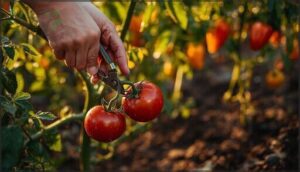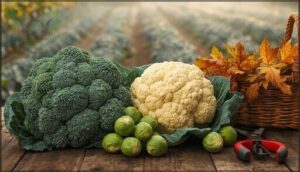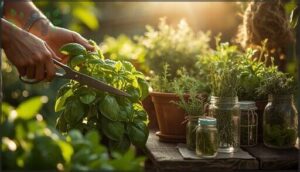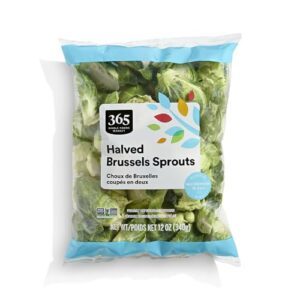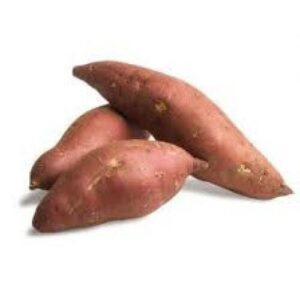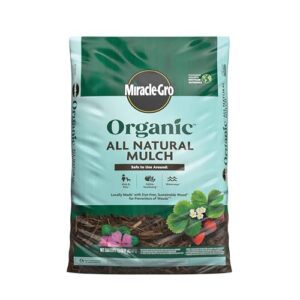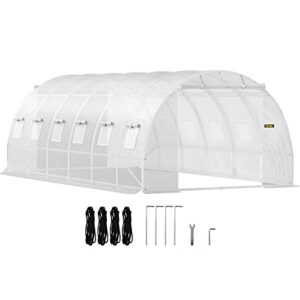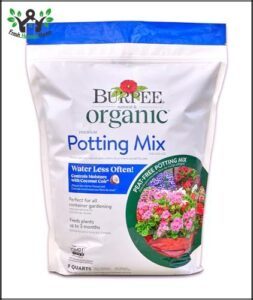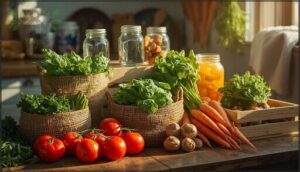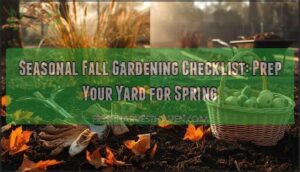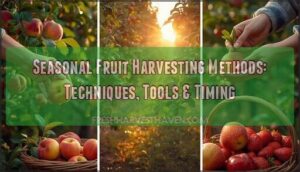This site is supported by our readers. We may earn a commission, at no cost to you, if you purchase through links.
Your first harvest can feel like striking gold—until you pick that tomato a week too early or leave those carrots in the ground so long they split and crack. Timing makes the difference between crisp, sweet vegetables and tough, bitter disappointments.
Most beginners think gardening ends when the first fruit appears, but knowing when and how to harvest determines whether your hard work pays off or ends up in the compost bin.
Seasonal harvesting tips for beginners start with reading the signs your plants give you—color shifts, texture changes, and size markers that tell you exactly when each crop hits its peak. Once you learn to spot these signals and match them to your local growing conditions, you’ll pull vegetables at their absolute best.
Table Of Contents
- Key Takeaways
- When to Harvest Seasonal Crops
- How to Harvest Different Vegetables
- Top 10 Products for Seasonal Harvesting
- 1. Fresh Halved Brussels Sprouts Bag
- 2. Bonnie Plants Early Girl Tomato
- 3. Organic Sweet Potato Delight
- 4. Organic Butternut Squash Vegetable
- 5. Garden Plant Protection Netting Cover
- 6. Natural Organic Garden Mulch Solution
- 7. Portable Walk In Greenhouse Tunnel
- 8. Hydroponics Growing System Indoor Garden
- 9. Blackout Curtains For Bedroom Windows
- 10. Burpee Premium Organic Potting Soil Mix
- Post-Harvest Handling and Storage Tips
- Essential Tools and Sustainable Practices
- Frequently Asked Questions (FAQs)
- Conclusion
Key Takeaways
- Harvest timing depends on visual cues like color shifts, texture changes, and size markers, not just calendar dates—tomatoes turn deep red, broccoli heads stay tight, and carrots show bright shoulders above soil when they’re ready.
- Different vegetables need different harvesting techniques to protect both plant and produce: root crops require loosened soil before pulling, leafy greens benefit from cut-and-come-again methods, and fruiting crops like tomatoes should be twisted or snipped rather than yanked.
- Post-harvest handling matters as much as growing—skip washing until you’re ready to use vegetables, store crops at their ideal temperatures (root vegetables near freezing, tomatoes at room temp), and cool harvested produce immediately since delays over two hours triple decay rates.
- Building healthy soil between seasons through crop rotation, cover crops, and mulch cuts pest problems by 30%, boosts nitrogen levels by 20%, and keeps your garden productive year after year without relying on extra fertilizer.
When to Harvest Seasonal Crops
Knowing when to pick your vegetables can feel like guesswork at first, but plants give you plenty of clues when they’re ready. You’ll want to watch for changes in color, size, and even how the weather’s behaving around harvest time.
Let’s walk through the key signs that tell you it’s time to grab your basket and head to the garden.
Signs of Vegetable Maturity
When you’re harvesting vegetables, you’ll notice several telltale signs of crop maturity. Visual cues like color shifts and texture indicators—such as a firm snap in green beans or resilient eggplant skin—tell you it’s time. Aroma signals become stronger in ripe tomatoes and melons. Size matters too; carrots and beets show readiness at specific diameters. Some crops even develop an abscission layer that makes harvest timing obvious. Understanding the proper harvest timing guidelines is key for best crop quality.
Color and Shape Indicators
You’ll see pigment transformation in action as your vegetables ripen. Tomatoes shift from green to deep red, while bell peppers turn yellow, orange, or red—these color changes signal peak ripeness. As fruits ripen, sugar production increases, influencing their overall flavor profile.
Shape matters too: broccoli heads should be tight and compact, cucumbers straight and firm. Check for glossiness indicators on eggplants—shiny skin means they’re ready, while dull surfaces show they’re past their prime.
Temperature and Frost Timing
Beyond color and shape, you’ll need to watch the thermometer and calendar closely. Frost date variability means your last spring frost—usually April 7–30 in Zone 5—could shift by two weeks year to year. Temperature crop sensitivity is real: warm-season vegetables suffer below 50°F and die in frost, while cool-season crops tolerate brief dips to 26–31°F. Climate change effects are pushing harvest windows earlier.
Here’s what matters for frost yield impact and best harvest temperatures:
- Hard frost (below 28°F) kills tender crops like tomatoes and peppers instantly
- Light frosts between 28–32°F halt warm-season growth even if mature fruit survives
- Cool-season vegetables handle cold better but lose quality after sustained freezing
- Soil temperatures below 55°F stop most annual vegetable growth completely
- Early frost before maturity can slash marketable yields by 30% in sensitive varieties
Days to Maturity Guidelines
Seed packets list “days to maturity,” but those numbers shift based on where you garden. Beans mature in 46–65 days, carrots in 42–56, and sweet corn in 70–100. Regional impacts matter: higher elevations can cut your season short by two months. Cultivar variability means the same broccoli variety might mature 20–32 days apart depending on planting date.
Here’s how maturity calculation affects harvest scheduling:
| Crop Type | Days to Maturity | Regional Adjustment |
|---|---|---|
| Beans | 46–65 days | Add 7–14 days in cool zones |
| Carrots | 42–56 days | Subtract 10 days in warm climates |
| Sweet Corn | 70–100 days | Varies ±22 days by location |
Accurate timing improves yield consistency and quality. Track your local weather patterns—temperature swings can shift expected harvest dates by up to two weeks. That’s why experienced gardeners keep a simple journal noting actual harvest times versus packet predictions for better planning next season.
How to Harvest Different Vegetables
Knowing when to pick is only half the battle—how you harvest matters just as much. Different vegetables have different needs, and using the right technique protects both your plant and your produce.
Let’s walk through the best ways to harvest each type of crop so you can get the most from your garden.
Harvesting Root Vegetables (Carrots, Beets, Radishes)
Root crops are like buried treasure—you can’t see them, but timing still matters. Carrots, beets, and radishes show they’re ready when their shoulders peek about an inch above the soil and colors look bright and full.
- Loosen soil with a spading fork 4–6 inches from rows before pulling to avoid snapping roots
- Harvest early morning when vegetables are fully hydrated for best crispness
- Pull carrots by tops with steady pressure after watering or rainfall
- Trim greens immediately, leaving 1 inch of stem to prevent moisture loss
Harvesting Leafy Greens (Lettuce, Spinach, Kale, Arugula)
Harvesting leafy greens like lettuce, spinach, kale, and arugula works best during cool morning hours when leaves are crisp. Cut outer leaves at the best time—before bolting starts—and use the cut-and-come-again method for multiple harvests.
Rinse with cold water, spin dry thoroughly, then store in breathable containers lined with paper towels. This keeps harvesting lettuce, spinach, and other leaf vegetables fresh for up to 10 days.
Harvesting Fruiting Crops (Tomatoes, Peppers)
When harvesting tomatoes and peppers, wait for that deep, rich color—it’s your best clue. Tomatoes need 60 to 100 days to reach maturity, while peppers should feel firm to the touch.
Gently twist or snip the stem with clean pruners to avoid plant damage. Harvesting techniques matter: handle fruits carefully to cut post-harvest losses and boost your yield.
Harvesting Brassicas (Broccoli, Cauliflower, Brussels Sprouts)
Ready to master brassicas? Harvest your broccoli when the head reaches about 6 inches across with tight buds. Cauliflower’s all about curd density—firm beats big. Brussels sprouts shine when they’re golf-ball sized.
These vegetables taste sweeter after a light frost, so don’t rush fall harvesting. Using staggered harvest timing and proper gardening tips ensures you’ll enjoy fresh brassicas for weeks.
Harvesting Herbs
Think of herbs like haircuts—snip often for bushier growth. Harvest when your basil hits 6 inches tall with several healthy leaves, and always take no more than one-third of the plant to keep it thriving.
Here are quick harvesting herbs tips to boost yield optimization and prevent post-harvest loss:
- Snip in the morning after dew dries to heighten essential oil content
- Use clean scissors to avoid spreading disease
- Store fresh-cut herbs in water like flowers, or dry them in cool, dark spots using proper storage techniques
Keep your herb maturity in check with these simple gardening tips, and you’ll enjoy fresh flavors all season.
Top 10 Products for Seasonal Harvesting
Having the right products on hand can turn your harvest from frustrating to fun. Whether you’re starting seeds, protecting plants from pests, or storing your bounty, a few smart purchases make all the difference.
Here are ten beginner-friendly products that’ll set you up for seasonal harvesting success.
1. Fresh Halved Brussels Sprouts Bag
You don’t always need to grow Brussels sprouts from seed to enjoy fresh seasonal harvesting. Grab a bag of fresh halved Brussels sprouts from brands like Taylor Farms or Marketside, and you’ll discover convenient Bagged Sprout Freshness that saves time on gardening prep.
These pre-trimmed vegetables deliver solid Sprouts Nutritional Value—3g protein and 330mg potassium per serving. Cooking Halved Sprouts is simple: roast, sauté, or steam them.
They’re perfect for understanding harvest timing since they’re picked at peak maturity, showing you what quality looks like when you start your own seasonal gardening tips journey.
Best For: Home cooks who want a quick, nutritious vegetable side without the hassle of trimming and halving fresh Brussels sprouts themselves.
- Pre-washed and halved so you can skip prep work and go straight to cooking—roasting, sautéing, or steaming in minutes.
- Solid nutritional profile with 3g of protein, 3g of fiber, and 330mg of potassium per serving, making them a healthy addition to any meal.
- Convenient 12-ounce bag size is perfect for meal prep or quick weeknight dinners without buying a full stalk you might not use.
- Freshness depends heavily on purchase date and how they’re stored, so they may spoil faster than whole sprouts on the stem.
- Not everyone enjoys the taste of Brussels sprouts, and the pre-halved format doesn’t change the flavor if you’re not already a fan.
- Higher price point compared to buying whole sprouts, since you’re paying for the convenience of pre-prep work.
2. Bonnie Plants Early Girl Tomato
If you want tomatoes on your table fast, Bonnie Plants Early Girl is your best friend. This variety gives you ripe fruit in just 50 days—perfect for satisfying that first-summer-harvest craving.
The Early Girl Yield is impressive: these indeterminate vines keep producing all season, and they’ve got solid Disease Resistance against verticillium and fusarium wilt.
Harvest Timing is simple—pick when they’re deep red and slightly soft. Plant Size reaches about 4 feet, so use a sturdy cage.
For Storage Tips, keep them on the counter, not the fridge.
Best For: Gardeners who want an early harvest of fresh slicing tomatoes and don’t mind providing support for tall, continuously producing vines.
- Produces ripe tomatoes in just 50 days, one of the fastest maturing slicing varieties available.
- Indeterminate growth means continuous production throughout the season, with some plants yielding up to 300 tomatoes under ideal conditions.
- Resistant to common diseases like verticillium wilt, fusarium wilt, and tomato mosaic virus, making it easier to grow successfully.
- Plant health upon delivery can be inconsistent, with some customers receiving dried-out or smaller-than-expected plants.
- Requires tall cages or stakes for support since vines often exceed 60 inches during peak season.
- Needs regular watering and full sun exposure to perform well, which may be challenging in some climates or for busy gardeners.
3. Organic Sweet Potato Delight
Organic sweet potatoes bring big rewards to your seasonal harvesting lineup. Market growth is booming—organic yields command a 14% higher selling price than conventional options, and consumer demand keeps climbing with 29% of buyers choosing organic when they can.
You’ll generally harvest 20,000 to 45,000 pounds per acre, depending on your cultivation practices. Profitability trends show organic gardening with sweet potatoes can earn you up to 52% more than regular vegetables. That’s a win for your soil and your wallet.
Best For: Health-conscious home cooks and gardeners who want premium organic produce that’s versatile enough for sweet or savory dishes and worth the investment for quality and nutrition.
- Packed with beta-carotene and fiber, making them a nutritious choice for snacking or cooking in everything from fries to baked dishes.
- Grown to high organic standards and stored fresh, so you’re getting quality produce without synthetic chemicals or GMOs.
- Incredibly versatile in the kitchen—roast them, mash them, bake them, or turn them into sweet potato fries for endless meal options.
- Some customers report the potatoes are larger than expected, which can make portion control and storage tricky.
- Shelf life can be inconsistent, with several reviews mentioning the potatoes may become stringy or spoil faster than anticipated.
- Priced higher than conventional sweet potatoes, which may not fit every budget despite the organic quality.
4. Organic Butternut Squash Vegetable
Butternut squash is a fall gardening champion, and the market trends don’t lie—organic butternut sales hit $1,620 million globally this year.
You’ll harvest when the skin shifts from green to tan, keeping at least an inch of stem attached for storage tips that extend freshness four to six months. Yields peak around 255 bushels per acre with smart fertilization.
This vegetable harvesting star delivers 50% of your daily vitamin A per serving, making butternut nutrition a real standout for home gardening tips.
Best For: Home gardeners and health-conscious cooks who want a nutrient-dense, versatile ingredient that stores for months and works in everything from soups to pies.
- Delivers 50% of daily vitamin A and 20% of vitamin C per serving, plus fiber and antioxidants that support overall health.
- Incredibly versatile in the kitchen—roast it, purée it for soups, mash it into baked goods, or use it in savory fall recipes.
- Stores for 4–6 months when cured properly, so you can buy in bulk and enjoy it well into winter.
- Size can be inconsistent, with some squash being too large for small households and others smaller than expected.
- Requires proper storage conditions (cool, dark, ventilated space) to maintain freshness and prevent spoilage.
- Any skin damage or blemishes can accelerate decay, so you need to inspect carefully before buying or storing.
5. Garden Plant Protection Netting Cover
Protection netting has quietly become the MVP of fall garden pest control. Crop losses drop by up to 90% when you drape this ultra-fine mesh over your beds. The 0.8 mm openings block aphids and carrot flies while letting rain and sunlight through, boosting environmental impact by cutting pesticide use over 80%.
Material durability runs three to five years, with costs ranging from $6.99 to $84.99, making cost analysis a no-brainer. Anchor it well during harvesting to avoid wind damage, and you’ll protect frost-sensitive crops while yields climb 20%.
Best For: Organic gardeners and home growers who want to cut pesticide use while protecting vegetables, fruits, and flowers from birds, bugs, and other pests across multiple growing seasons.
- Slashes crop losses by up to 90% and can boost yields by 20% while letting water, air, and sunlight reach your plants naturally.
- Lasts 3–5 years and pays for itself quickly by reducing pesticide costs by over 80%, with prices starting under $7.
- Ultra-fine 0.8 mm mesh blocks tiny pests like aphids and carrot flies without chemicals, making it safe for kids, pets, and beneficial insects.
- Needs solid anchoring with stakes or weights since wind can lift or tear the lightweight material, especially in exposed areas.
- Some users report the mesh rips or frays more easily than expected, particularly around edges or where clips create pressure points.
- Can be tricky to see through in bright sunlight, making it harder to check on plants without lifting the netting.
6. Natural Organic Garden Mulch Solution
Around your freshly harvested beds, a three-inch layer of organic mulch benefits soil health in surprising ways. This sustainable mulch sourcing option retains moisture 50–80% better than bare ground while slashing weeds.
Application best practices say keep it several inches from stems to avoid rot. Mulch pest control works naturally, cutting thrips and fungal disease by blocking spore splash during rain.
Made from recycled wood waste and OMRI-listed for organic material use, it covers about six square feet per bag and feeds your soil as it breaks down.
Best For: Gardeners looking for an eco-friendly way to suppress weeds, retain moisture, and improve soil health around established plants in organic gardens.
- Locally made from recycled wood waste and OMRI-listed for organic use, so it’s sustainable and safe around edible plants, kids, and pets.
- Retains soil moisture 50–80% better than bare ground and blocks weeds effectively when applied as a 3-inch layer.
- Breaks down over time to feed the soil, improving nutrient cycling and supporting beneficial microbes while reducing pest and disease pressure.
- Can’t be used around young seedlings or undeveloped plants, and needs to be kept away from tree trunks and wood structures to prevent rot.
- Takes a long time to absorb water initially, which some gardeners find frustrating during setup.
- Individual boxes may create extra packaging waste, and coverage is limited to about 6 square feet per bag.
7. Portable Walk In Greenhouse Tunnel
A 20x10x7-foot walk-in tunnel extends your growing season by keeping internal temperatures 55–65°F warmer than outside—perfect for cold frame gardening. This greenhouse method lets you fine-tune temperature regulation through 12 mesh windows and roll-up doors, boosting crop yield even when frost threatens.
The galvanized steel frame and waterproof PE cover handle snow and rain, while good ventilation aids pest control and healthy seasonal harvesting.
At around $74, the cost analysis makes sense for serious beginners mastering year-round harvesting techniques.
Best For: Gardeners in cold climates who want to extend their growing season without spending thousands on a permanent structure.
- Maintains temperatures 55–65°F warmer than outside, letting you grow year-round even in freezing conditions.
- Easy setup with included tools and a galvanized steel frame that holds up against rain, snow, and UV damage.
- Twelve mesh windows and two roll-up doors give you full control over ventilation to prevent overheating and keep plants healthy.
- The PE cover and zippers tend to wear out after a year or two, especially in harsh weather.
- Stakes and ropes might not hold up in high winds—you may need to add extra anchoring.
- Assembly instructions can be confusing at first, though it gets easier once you start putting it together.
8. Hydroponics Growing System Indoor Garden
A 12-pod hydroponic system brings urban gardening indoors with LED grow lights and a whisper-quiet pump under 20 dB. The 6.5L tank and adjustable light height suit beginners mastering indoor growing and harvesting techniques.
You’ll harvest leafy greens and herbs year-round while enjoying hydroponics benefits like 90% water conservation compared to soil beds. Crop yields accelerate thanks to controlled nutrients and light cycles.
System maintenance stays simple with automated watering, though you’ll want a pH meter for peak vegetable gardening results.
Best For: Urban dwellers and beginner gardeners who want fresh herbs and greens year-round without the hassle of soil or outdoor space.
- Grows plants up to 5 times faster than traditional methods with full-spectrum LED lighting and automated nutrient delivery
- Saves up to 90% more water than soil gardening through recirculation, plus the whisper-quiet pump (under 20 dB) won’t disrupt your living space
- Simple setup with three plant modes and adjustable light height makes it easy for anyone to start harvesting, regardless of experience level
- Pump reliability can be hit-or-miss over time, and some users report the LED light occasionally shuts off unexpectedly
- You’ll need to buy extras like a pH meter and hydroponic fertilizer separately to get the best results
- The 21-inch height limit and 12-pod capacity won’t work for taller plants or anyone wanting to grow large quantities
9. Blackout Curtains For Bedroom Windows
You might wonder what blackout curtains have to do with seasonal gardening—turns out, they’re a major advantage for indoor seed starting. These 84″L faux linen panels deliver 100% light blocking and energy savings up to 15% on cooling costs, perfect when you’re nursing seedlings under grow lights. The dual-tab design simplifies installation, while noise reduction creates a calm space for planning your vegetables and harvesting techniques.
With the market hitting $12.19 billion in 2024, more beginners guide their indoor-outdoor seasonal gardening setups using thermal curtains.
Best For: People who need complete darkness for better sleep, want to cut energy costs, or are looking for privacy and noise reduction in bedrooms or living rooms.
- Blocks 100% of light and UV rays, which helps you sleep better and protects your furniture from sun damage.
- Saves 10-15% on cooling costs by keeping heat out during summer and warmth in during winter.
- Machine-washable and comes with two hanging options (rod pocket and back tabs) for easy setup.
- The rubberized backing can make the curtains stick a bit when you’re opening or closing them.
- Color might look different in person depending on your room’s lighting.
- Some customers received incomplete sets or the wrong product in their order.
10. Burpee Premium Organic Potting Soil Mix
You’ll get healthier vegetables when you start with the right soil composition—Burpee Premium Organic Potting Mix delivers that foundation.
This 9-quart blend combines coconut coir for moisture retention with slow-release plant food lasting three months, perfect for container planting and raised beds.
Its organic certification means no synthetic chemicals touch your harvest, while the sustainable gardening approach uses renewable coir instead of peat moss.
Customer reports show increased yields and stronger root development. At $5.20, it aids nutrient delivery from seed to garden table.
Best For: Home gardeners who want certified organic soil that supports container vegetables, herbs, and flowers with minimal fertilizing for three months.
- Contains coconut coir that holds moisture well and reduces watering frequency while providing excellent drainage for container plants.
- OMRI-listed organic formula with slow-release nutrients means no synthetic chemicals and less frequent feeding needed.
- Users consistently report stronger yields and healthier root systems compared to standard potting mixes.
- Costs more per quart than many competing potting soil brands on the market.
- Some gardeners find the natural organic smell noticeably strong when first opening the bag.
- The 9-quart size may be too small for larger gardening projects or multiple raised beds.
Post-Harvest Handling and Storage Tips
You’ve done the hard work of growing and picking your vegetables, but what happens next can make or break your harvest. How you handle and store your produce right after picking determines how long it stays fresh and flavorful.
Let’s walk through some simple strategies that’ll help you get the most out of every crop you bring in from the garden.
Cleaning and Preparing Harvested Produce
You’ve just pulled your harvest—now what? Brushing off dirt beats washing right away, since excess water opens the door to contamination risks. When you do wash, keep water within 10°F of your vegetables’ temp to protect shelf life.
Sorting out damaged produce and drying greens well prevents spoilage. These simple harvest preparation steps dramatically improve food storage for all your fruits and vegetables.
Storage Methods for Different Vegetables
Now you need proper storage methods suited to what you grew. Root vegetable storage works best at near-freezing temps—carrots in damp sand last five months at 32°F.
Leafy green storage demands cold, moist conditions between 32°F and 39°F for up to two weeks.
Fruiting vegetable storage differs: keep tomatoes at 55°F on the counter, while peppers prefer 44°F refrigeration for extending harvest freshness.
Preventing Moisture Loss and Spoilage
Proper humidity control between 85% and 95% stops moisture loss after storage begins. Temperature management below 50°F can cut spoilage rates by half for leafy greens. Here’s what protects your hard work:
- Use airtight packaging barriers to reduce water loss by up to 70%
- Never wash vegetables before postharvest storage—it raises spoilage risks by 25%
- Cool harvested crops immediately—delays over two hours triple decay rates
- Check storage infrastructure for proper ventilation and pest prevention daily
Extending Harvest Freshness
Beyond preventing spoilage, you can actually push freshness further with the right techniques. Cold storage at 32°F stretches shelf life by 50% compared to warmer temps. MAP technology—those special gas-mix packages—adds another 3–10 days of crispness.
Try curing techniques for root crops: dry your onions and potatoes in well-ventilated shade before storing harvested crops long-term.
Essential Tools and Sustainable Practices
Getting your hands on the right tools makes harvest season so much easier, and building healthy soil habits keeps your garden strong year after year. You don’t need a shed full of fancy equipment—just a few smart essentials and some simple practices that work with nature instead of against it.
Let’s look at what actually matters regarding tools, rotation, and keeping your soil in great shape.
Must-Have Harvesting Tools
You don’t need a shed full of fancy gadgets to bring in a great harvest. Just a few essential tools for seasonal harvesting will make your work easier and protect your crops from damage.
- Hand pruners and scissors – Sharp bypass pruners cut cleanly through stems without crushing, which is key for delicate herbs and leafy greens.
- Harvest knives – A serrated blade works with tougher vegetables like cabbage and squash with less effort than pulling or twisting.
- Breathable baskets or containers – Vented bins let air flow around freshly picked produce, keeping it cool and preventing bruising during transport from garden to kitchen.
Implementing Crop Rotation
When you plant the same vegetable in one spot year after year, pests multiply and soil loses its punch. Crop rotation flips that script. Moving vegetable families to new beds every 3-4 years cuts pest problems by 30% and improves soil fertility considerably.
Rotating crops every few years slashes pests by 30% and revives tired soil naturally
Planning rotations with legumes, cereals, and cover crops keeps your garden thriving while slashing the need for extra fertilizer.
| Rotation Benefit | Impact |
|---|---|
| Pest reduction | Up to 30% fewer problems |
| Soil fertility boost | Nitrogen levels up 50% |
| Disease control | 40% less incidence |
| Yield improvement | 11-13% increase |
| Soil erosion decrease | About 25% reduction |
Using Cover Crops and Mulch
After harvest wraps up, your soil craves protection and a nutritional boost. Cover crops and mulch work as a power duo for sustainable gardening. Here’s how they transform your beds:
- Cover crops increase soil nitrogen by 20% while fixing nutrients and blocking weeds during off-seasons—legumes shine brightest here.
- Mulch cuts soil moisture loss dramatically, letting you water less while keeping temperatures 20°C cooler and stopping erosion cold.
- Together they crush weed control, with mulch blocking sunlight and cover crops smothering germination spots before weeds take hold.
Both enrich nutrient management naturally as organic matter breaks down, feeding beneficial microbes that keep your soil healthy and productive between plantings.
Maintaining Soil Health Between Seasons
Since your garden beds sit empty between seasons, microbial activity and soil health need intentional care. Crop rotation prevents nutrient depletion, while cover crops boost nitrogen and control erosion. No-till methods preserve soil structure better than conventional tillage, and composting adds organic matter that feeds beneficial microbes. Regular soil amendments keep your beds productive year after year.
Frequently Asked Questions (FAQs)
How do I know when squash is overripe?
Check the squash skin texture—if it’s soft, wrinkled, or has dark spots, you’ve waited too long. A dried-out stem and dull color change signs also mean it’s overripe.
Can I harvest vegetables in the rain?
It’s tempting to grab those ripe tomatoes during a downpour, but waiting 24 hours after rain cuts bacterial contamination risk considerably.
Wet harvesting invites spoilage, pathogen growth, and up to 38% higher storage losses.
What causes bitter-tasting lettuce after picking?
Heat stress during growth and post-harvest chemical changes trigger bitterness in lettuce. Sesquiterpene lactones jump 30% within 48 hours after picking. Harvest timing matters—morning-picked, immediately cooled lettuce stays sweeter longer.
Should I fertilize right before harvesting crops?
Skip fertilizing right before harvesting vegetables—it won’t boost yield and risks nutrient leaching. Instead, apply fertilizer early when crops actively grow.
Late fertilization harms soil health and wastes money without improving your harvest.
How do I store harvested seeds properly?
Like tucking away treasures for next year’s garden, seed storage starts with proper drying—aim for 13–16% moisture—then seal them in airtight containers at cool temperatures (35–40°F) to preserve viability.
Conclusion
Harvest timing works like catching a wave—wait too long and you miss it, jump too early and you wipe out. These seasonal harvesting tips for beginners give you the signals to watch, the techniques to use, and the confidence to pull crops at their peak.
Start small, pay attention to what your garden tells you, and you’ll soon be filling baskets with vegetables that taste as good as they look.
- https://apps.fas.usda.gov/psdonline/circulars/production.pdf
- https://swat.tamu.edu/media/90113/crops-typicalplanting-harvestingdates-by-states.pdf
- https://www.reddit.com/r/gardening/comments/183uj9p/best_yielding_vegetables/
- https://fredblog.stlouisfed.org/2020/08/seasonality-in-food-prices-a-bountiful-harvest-of-fred-data/
- https://lifestyle.sustainability-directory.com/question/how-can-seasonal-eating-reduce-food-waste/




